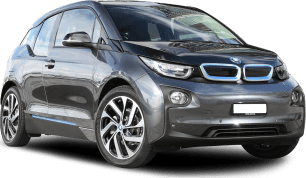The bluff shape of the i3 lends itself to being quite roomy. There is quite a lot of headroom and sufficient leg and foot room for rear seat passengers, while an almost complete absence of a transmission tunnel gives the rear seat passengers an extra measure of space.
It's strictly a four-person car only. There are cup holders for the rear in the middle of the rear seats, and there are two cup holders line astern in the front of the car.
BMW is rightly proud of the alternate materials that are used in the BMW i3.
Again, the lack of a traditional transmission means there's a great deal of space for both driver and passenger, but the door sills of the carbon fibre reinforced plastic safety cell are very high when getting in and out of the car.
BMW is rightly proud of the alternate materials that are used in the BMW i3. The dash, for example, is made of a recycled natural fibre, but unfortunately, it ends up looking like the underside of a luggage cover in a cheaper car.
It's easy to see what BMW is doing, but in this instance - and particularly in contrast with the eucalyptus wood dash laminates - it just doesn't ring true. Luckily, other material finishes can be optioned to bring it into line with the rest of the cabin.
Probably the most unusual element of driving the i3 is the jog-shuttle style gear shift. Once you get your head around the idea that you twist your hand towards the driver to engage D and away to engage reverse, it's actually quite easy.
The steering wheel spoke, however, can hide the start/stop button and the awkwardly placed parking mode button. If you're not familiar with the car, it can be confusing.
The rest of the switch gear is familiar territory for BMW, and features a three mode drive select switch featuring Comfort (or normal), Eco Pro (which accentuates efficient driving) and Eco Pro+, which strives for maximum range by turning off climate control and limiting the car to 90km/h.
With a large glasshouse, the i3 is supremely easy to look out of, with large three-quarter glass and good visibility out of the smallish rear window.
The view through the steering wheel lands on a narrow, tablet-style instrument screen.
No visibility issues with the system and all its vital information, including a digital speedo, range, percentage of battery life left, how many kilowatts per hour, or kilowatt hours for 100 kilometres, you're using. It's a weird way to measure economy, but that's what you get when you run a proper EV.
There are two ISOFIX baby seat mounts in the back, and the rear seats do flip down to give you more cargo room, although the floor of the cargo area is raised quite high thanks to the electric motor in the rear of the car.
There is 260 litres of luggage space on offer with the seats up, and a practical and useful 1100 litres with the seats down.
When it comes to practicality of use, the EV has a fatal flaw – it's relatively inflexible. For example, I wanted to do a 90-minute round-trip before our photo shoot with the i3.
Vehicle charging infrastructure in Australia is in its absolute infancy, despite the decade that electric cars have been on sale.
If I had taken the i3, I would have depleted the battery to the point where we wouldn't get to our shoot, and there was no time to recharge between tasks. Result? I had to take another car.
This is the reality of an electric car owner's life in a nutshell. If you have a fixed route, say between home and work, and you can access a reasonably fast charging system, then the i3 - and all electric cars - work spectacularly well.
However, vehicle charging infrastructure in Australia is in its absolute infancy, despite the decade that electric cars have been on sale. In my hometown of 400,000 people, there are less than five commercial chargers, and not all of them work on any given day.






